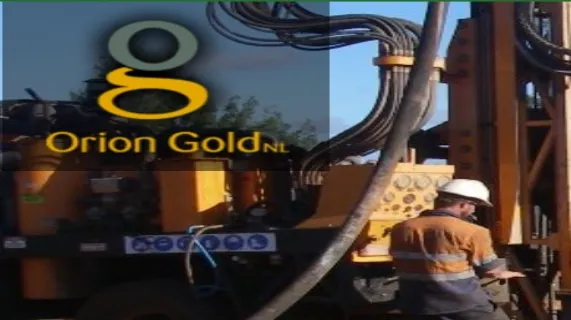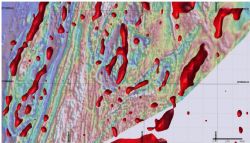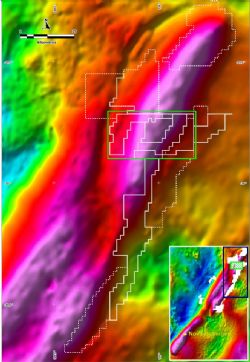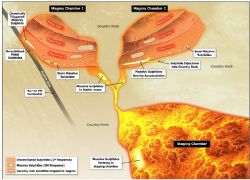
New Targets Identified at Fraser Range
Perth, May 26, 2015 AEST (ABN Newswire) - Orion Gold NL ( ASX:ORN) is pleased to advise that it has identified a number of new exploration targets within its extensive 4,500km2 Fraser Range landholding in Western Australia, and progressed several existing targets, through the application of state-of-the-art exploration methodologies.
ASX:ORN) is pleased to advise that it has identified a number of new exploration targets within its extensive 4,500km2 Fraser Range landholding in Western Australia, and progressed several existing targets, through the application of state-of-the-art exploration methodologies.
The new targets were identified using constrained gravity inversion modelling, which is growing in importance as an exploration technique in the Albany-Fraser province, while previously defined targets have been progressed by integrating the results of the gravity modelling with data from magnetic and electromagnetic ("EM") surveys (see Figures 1 and 2; ASX Release 3 February 2014).
The targets are believed to represent mafic-ultramafic intrusions due to the elevated sub-surface density interpreted within these areas, and are therefore prospective for magmatic Ni-Cu mineralisation. This increases the overall number of priority targets defined by the Company within the Fraser Range Project to 34, of which the Company has only drill tested four to date.
A target-ranking exercise is currently underway to enable the Company to design appropriate work programs to test each of these targets in coming months, with upcoming programs being planned including high-powered EM, aircore and percussion drilling and, ultimately, RC and diamond target drilling.
Gravity Inversion Modelling - A New Exploration Approach
Previous drilling by the Company within the Plumridge Igneous Complex, which contains the Pennor and HA2 Prospects, intersected mafic-ultramafic bodies which have since been confirmed as genetically related intrusive bodies, all of which have key characteristics making them highly prospective for the discovery of nickel-copper sulphide mineralisation (refer ASX Release - 26 September 2014).
Both altered and unaltered intrusive bodies were intersected in this drilling, and the density (or specific gravity "SG") properties of these bodies was observed to have changed with alteration. Altered mafic-ultramafic intrusives have a significantly lower SG relative to the SG of a fresh, unaltered, mafic intrusive rock.
The Company has therefore applied a "gravity inversion" technique to its high-resolution ground gravity dataset to generate a model of sub-surface density variations. The aim was to identify those bodies with a density fitting the target range for mafic-ultramafic intrusives. A significant number of bodies have been identified with the high SG characteristic of mafic intrusions in the Albany-Fraser Belt, as shown in Figures 1 and 2 in link below:
It is noteworthy that a substantial number of the new targets identified - including some of the largest bodies - lie beneath deeper, modern sediment cover in the eastern project area, where airborne EM has been ineffective and, in some cases, where high-resolution magnetic data has not yet been acquired.
During 2014 the Company's exploration activities were focused on the Peninsula-HA2 and Pennor Prospects within the Plumridge Igneous Complex, where a significant amount of historical data was available.
In parallel with testing of this target, the Company has continued acquiring and processing data aimed at defining and ranking targets in the wider project area. These investigations are focused on identifying suitable hosts for massive sulphide nickel-copper accumulations in areas where airborne EM is likely to be ineffective due to the presence of thick, conductive cover sequences.
Background - Gravity Modelling
The primary work program has been a combination of structural interpretation using surface images and magnetic data and interpretation of gravity data collected by the Company in December 2013.
The gravity inversion modelling process has been constrained using the depth of cover based on drilling, together with other available data, and restricting the range of densities attributable to each cell based on published data from elsewhere in the Albany-Fraser Belt.
The primary objective of the modelling exercise was to map sub-surface variations in density and identify areas where the underlying rocks have a density of 3.0g/cm3 or above.
The Company has targeted this density because it matches the density of fresh mafic gabbros measured elsewhere in the Albany-Fraser Belt, sourced from data published by the Geological Survey of Western Australia (GSWA) and used by the GSWA in regional-scale inversion models.
The mafic intrusions of the Fraser Zone have a density significantly higher than the average crustal rocks in the Albany-Fraser belt and stand out as "highs" (see Figure 1). There are no other lithologies identified in the belt which give rise to such gravity high features.
Importantly, the modelling indicates the presence of a significant dense body at depth beneath the project area, with the bodies closer to surface emerging as apophyses from this larger body.
This fits with the general deposit model that has been developed for the Company's Fraser Range Project Area, where the mafic-ultramafic intrusions intersected near surface show evidence of having been extruded from larger staging chambers which lie at depth.
Data from the Company's drilling programs has enabled the robustness of the gravity modelling to be assessed independently and in general there is good correlation between the location of mafic-ultramafic intrusions intersected in drilling and the locations predicted by the gravity model, based on drilling to date.
Significantly, there are a number of "negative" anomalies adjacent to the interpreted dense, mafic bodies (see Figure 5 in link below). These anomalies denote areas where the sub-surface material is modelled to be 2.5g/cm3 or less. Densities of this magnitude could either represent metasediments/gneisses of the Biranup Complex, or, importantly in some cases, map zones where alteration has reduced the density of a mafic rock as a result of the properties/minerals of the parent mafic-ultramafic intrusives being changed to their alteration products.
An example of this process was encountered at the HA2 prospect, where drilling of a "gravity high" feature in the western lobe encountered a fresh unaltered mafic intrusive with disseminated nickel-copper sulphides, while drilling in the altered mafic-ultramafic eastern "gravity low" lobe intersected higher concentrations of sulphides and returned a thick intersection of 80m at 0.11% Ni in OPRC008 (refer ASX Release - 17 March 2014).
Geochemical modelling has shown that these two intrusive lobes, with contrasting gravity and magnetic signatures, came from the same source (refer ASX Release - 13 May 2014).
Alerted by the recognition of pervasive alteration of some nickel-copper-bearing intrusions in the project area, as well as evidence of resultant mobilisation of metals within these intrusions and into contact zones, the Company has identified additional areas of interest with the potential to host metals that may have been remobilised from their intrusive sources during subsequent alteration.
This genetic process is important at the Thompson Nickel Deposit in Canada, where deformation of the host ultramafic intrusion led to remobilisation of some of the metalbearing sulphides along structural conduits and re-deposition in the periphery to the magma source.
Forward Program
An ongoing program is underway to rank the newly identified targets and design appropriate work programs to test each of these targets in coming months.
Planned follow-up work will include acquiring high-powered ground EM over target bodies and testing some of the targets with aircore and percussion drilling in order to confirm the presence of mafic-ultramafics intrusives as well as determine their characteristics.
To view all tables and figures, please visit:
http://media.abnnewswire.net/media/en/docs/80028-ASX-ORN-423900.pdf
Contact
Errol Smart - Managing Director and CEO
Denis Waddell - Chairman
T: +61 8 9485 2685
E: info@oriongold.com.au
| ||
|










